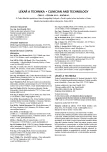VENTILATOR CIRCUIT MODEL FOR OPTIMIZATION OF HIGH-FREQUENCY OSCILLATORY VENTILATION
Ventilators for high-frequency oscillatory ventilation (HFOV), Sensormedics 3100, were not designed to tolerate spontaneous breathing of a patient. An experimental Demand Flow System (DFS) is being developed to support spontaneous breathing during HFOV. A control system of the DFS requires a model of the ventilator circuit of Sensormedics 3100. A new model of the circuit was designed, including the oscillating membrane, the inspiratory and expiratory branches of the circuit, the expiratory valve, and a spontaneously breathing patient. The model was implemented in the Multisim software environment. A bench test suggests that the model predicts the basic changes in pressure within the ventilator circuit and that its modified version can be used in the DFS control algorithm.
Keywords:
high-frequency oscillatory ventilation (HFOV), ventilator circuit, lumped-parameter model, electro-acoustic analogy
Autoři:
Jan Matějka; Jakub Ráfl; Michal Čech; Martin Rožánek
Působiště autorů:
Czech Technical University in Prague, Faculty of Biomedical Engineering, Kladno, Czech Republic
Vyšlo v časopise:
Lékař a technika - Clinician and Technology No. 2, 2012, 42, 61-64
Kategorie:
Conference YBERC 2012
Souhrn
Ventilators for high-frequency oscillatory ventilation (HFOV), Sensormedics 3100, were not designed to tolerate spontaneous breathing of a patient. An experimental Demand Flow System (DFS) is being developed to support spontaneous breathing during HFOV. A control system of the DFS requires a model of the ventilator circuit of Sensormedics 3100. A new model of the circuit was designed, including the oscillating membrane, the inspiratory and expiratory branches of the circuit, the expiratory valve, and a spontaneously breathing patient. The model was implemented in the Multisim software environment. A bench test suggests that the model predicts the basic changes in pressure within the ventilator circuit and that its modified version can be used in the DFS control algorithm.
Keywords:
high-frequency oscillatory ventilation (HFOV), ventilator circuit, lumped-parameter model, electro-acoustic analogy
Zdroje
[1] Roubík, K., Ráfl, J., van Heerde, M., Markhorst, D. G. Design and control of a demand flow system assuring spontaneous breathing of a patient connected to an HFO ventilator. IEEE Trans Biomed Eng, 2011, vol. 58, no. 11, p. 3225–3233.
[2] van Heerde, M., et al. Unloading work of breathing during high-frequency oscillatory ventilation: A bench study. Critical Care, 2006, vol. 10, no. 4, p. R103.
[3] Škvor, Z. Vibrating systems and their equivalent circuits. 2nd ed. Prague: Academia, 1991.
[4] Bates, J. H. T. Lung mechanics: An inverse modeling approach. 1st ed. New York: Cambridge University Press, 2009.
[5] Matějka, J. Model pacientského okruhu pro optimalizaci vysokofrekvenční oscilační ventilace. [Bachelor thesis]. Prague: CTU FBMI, 2012.
[6] Čech, M. Modelování a měření základních komponent v respirační péči. [Bachelor thesis]. Prague: CTU FBMI, 2012.
[7] van Genderingen, H. R., et al. Reduction of oscillatory pressure along the endotracheal tube is indicative for maximal respiratory compliance during high-frequency oscillatory ventilation: A mathematical model study. Pediatric Pulmonology, 2001, vol. 31, no. 6, p. 458–463.
[8] Schranz, C., Moeller, K. Inverse modeling supports quantification of pressure and time depending effects in ARDS patients. In: 33rd Annual International Conference of the IEEE EMBS, Boston, Aug 30–Sep 3, 2011, p. 1013–1016.
[9] Schranz, C., Moeller, K. Model-based quantification of pressure and time depending effects in ARDS patients. In: 5th International Conference on Bioinformatics and Biomedical Engineering (iCBBE), Wuhan, May 10–12, 2011, p. 1–4.
[10] Pino, A. V., Giannella-Neto, A. A new method to obtain a positive end-expiratory pressure. In: Proceedings of the 18th Annual International Conference of the IEEE EMBS, Amsterdam, Oct 31–Nov 3, 1996, p. 1689–1690.
Štítky
BiomedicínaČlánok vyšiel v časopise
Lékař a technika

2012 Číslo 2
Najčítanejšie v tomto čísle
- MECHANICAL MODEL OF THE CARDIOVASCULAR SYSTEM: DETERMINATION OF CARDIAC OUTPUT BY DYE DILUTION
- MATLAB AND ITS USE FOR PROCESSING OF THERMOGRAMS
- The Fifth Biomedical Engineering Conference of Young Biomedical Engineers and Researchers
- VALUATION METHODOLOGY FOR MEDICAL DEVICES
